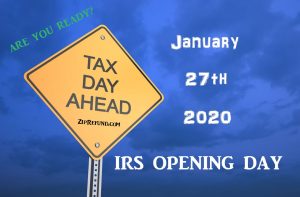IR-2022-08, January 10, 2022
WASHINGTON — The Internal Revenue Service announced that the nation’s tax season will start on Monday, January 24, 2022, when the tax agency will begin accepting and processing 2021 tax year returns.
The January 24 start date for individual tax return filers allows the IRS time to perform programming and testing that is critical to ensuring IRS systems run smoothly. Updated programming helps ensure that eligible people can claim the proper amount of the Child Tax Credit after comparing their 2021 advance credits and claim any remaining stimulus money as a Recovery Rebate Credit when they file their 2021 tax return.
“Planning for the nation’s filing season process is a massive undertaking, and IRS teams have been working non-stop these past several months to prepare,” said IRS Commissioner Chuck Rettig. “The pandemic continues to create challenges, but the IRS reminds people there are important steps they can take to help ensure their tax return and refund don’t face processing delays. Filing electronically with direct deposit and avoiding a paper tax return is more important than ever this year. And we urge extra attention to those who received an Economic Impact Payment or an advance Child Tax Credit last year. People should make sure they report the correct amount on their tax return to avoid delays.”
The IRS encourages everyone to have all the information they need in hand to make sure they file a complete and accurate return. Having an accurate tax return can avoid processing delays, refund delays and later IRS notices. This is especially important for people who received advance Child Tax Credit payments or Economic Impact Payments (American Rescue Plan stimulus payments) in 2021; they will need the amounts of these payments when preparing their tax return. The IRS is mailing special letters to recipients, and they can also check amounts received on IRS.gov.
Like last year, there will be individuals filing tax returns who, even though they are not required to file, need to file a 2021 return to claim a Recovery Rebate Credit to receive the tax credit from the 2021 stimulus payments or reconcile advance payments of the Child Tax Credit. People who don’t normally file also could receive other credits.
April 18 tax filing deadline for most
The filing deadline to submit 2021 tax returns or an extension to file and pay tax owed is Monday, April 18, 2022, for most taxpayers. By law, Washington, D.C., holidays impact tax deadlines for everyone in the same way federal holidays do. The due date is April 18, instead of April 15, because of the Emancipation Day holiday in the District of Columbia for everyone except taxpayers who live in Maine or Massachusetts. Taxpayers in Maine or Massachusetts have until April 19, 2022, to file their returns due to the Patriots’ Day holiday in those states. Taxpayers requesting an extension will have until Monday, October 17, 2022, to file.
Awaiting processing of previous tax returns? People can still file 2021 returns
Rettig noted that IRS employees continue to work hard on critical areas affected by the pandemic, including processing of tax returns from last year and record levels of phone calls coming in.
“In many areas, we are unable to deliver the amount of service and enforcement that our taxpayers and tax system deserves and needs. This is frustrating for taxpayers, for IRS employees and for me,” Rettig said. “IRS employees want to do more, and we will continue in 2022 to do everything possible with the resources available to us. And we will continue to look for ways to improve. We want to deliver as much as possible while also protecting the health and safety of our employees and taxpayers. Additional resources are essential to helping our employees do more in 2022 – and beyond.”
The IRS continues to reduce the inventory of prior-year individual tax returns that have not been fully processed. As of December 3, 2021, the IRS has processed nearly 169 million tax returns. All paper and electronic individual 2020 refund returns received prior to April 2021 have been processed if the return had no errors or did not require further review.
Taxpayers generally will not need to wait for their 2020 return to be fully processed to file their 2021 tax returns and can file when they are ready.
Key information to help taxpayers
The IRS encourages people to use online resources before calling. Last filing season, as a result of COVID-era tax changes and broader pandemic challenges, the IRS phone systems received more than 145 million calls from January 1 – May 17, more than four times more calls than in an average year. In addition to IRS.gov, the IRS has a variety of other free options available to help taxpayers, ranging from free assistance at Volunteer Income Tax Assistance and Tax Counseling for the Elderly locations across the country to the availability of the IRS Free File program.
“Our phone volumes continue to remain at record-setting levels,” Rettig said. “We urge people to check IRS.gov and establish an online account to help them access information more quickly. We have invested in developing new online capacities to make this a quick and easy way for taxpayers to get the information they need.”
Last year’s average tax refund was more than $2,800. More than 160 million individual tax returns for the 2021 tax year are expected to be filed, with the vast majority of those coming before the traditional April tax deadline.
Overall, the IRS anticipates most taxpayers will receive their refund within 21 days of when they file electronically if they choose direct deposit and there are no issues with their tax return. The IRS urges taxpayers and tax professionals to file electronically. To avoid delays in processing, people should avoid filing paper returns wherever possible.
By law, the IRS cannot issue a refund involving the Earned Income Tax Credit or Additional Child Tax Credit before mid-February, though eligible people may file their returns beginning on January 24. The law provides this additional time to help the IRS stop fraudulent refunds from being issued.
Some returns, filed electronically or on paper, may need manual review, which delays the processing, if our systems detect a possible error or missing information, or there is suspected identity theft or fraud. Some of these situations require us to correspond with taxpayers, but some do not. This work does require special handling by an IRS employee so, in these instances, it may take the IRS more than the normal 21 days to issue any related refund. In those cases where IRS is able to correct the return without corresponding, the IRS will send an explanation to the taxpayer.
File electronically and choose direct deposit
To speed refunds, the IRS urges taxpayers to file electronically with direct deposit information as soon as they have everything they need to file an accurate return. If the return includes errors or is incomplete, it may require further review that may slow the tax refund. Having all information available when preparing the 2021 tax return can reduce errors and avoid delays in processing.
Most individual taxpayers file IRS Form 1040 or Form 1040-SR once they receive Forms W-2 and other earnings information from their employers, issuers like state agencies and payers. The IRS has incorporated recent changes to the tax laws into the forms and instructions and shared the updates with its partners who develop the software used by individuals and tax professionals to prepare and file their returns. Forms 1040 and 1040-SR and the associated instructions are available now on IRS.gov. For the latest IRS forms and instructions, visit the IRS website at IRS.gov/forms.
Free File available January 14
IRS Free File will open January 14 when participating providers will accept completed returns and hold them until they can be filed electronically with the IRS. Many commercial tax preparation software companies and tax professionals will also be accepting and preparing tax returns before January 24 to submit the returns when the IRS systems open.
The IRS strongly encourages people to file their tax returns electronically to minimize errors and for faster refunds – as well having all the information they need to file an accurate return to avoid delays. The IRS’s Free File program allows taxpayers who made $73,000 or less in 2021 to file their taxes electronically for free using software provided by commercial tax filing companies. More information will be available on Free File later this week.
In addition to IRS Free File, the IRS’s Volunteer Income Tax Assistance and Tax Counseling for the Elderly programs free basic tax return preparation to qualified individuals.
Watch for IRS letters about advance Child Tax Credit payments and third Economic Impact Payments
The IRS started sending Letter 6419, 2021 advance Child Tax Credit, in late December 2021 and continues to do so into January. The letter contains important information that can help ensure the return is accurate. People who received the advance CTC payments can also check the amount of the payments they received by using the CTC Update Portal available on IRS.gov.
Eligible taxpayers who received advance Child Tax Credit payments should file a 2021 tax return to receive the second half of the credit. Eligible taxpayers who did not receive advance Child Tax Credit payments can claim the full credit by filing a tax return.
The IRS will begin issuing Letter 6475, Your Third Economic Impact Payment, to individuals who received a third payment in 2021 in late January. While most eligible people already received their stimulus payments, this letter will help individuals determine if they are eligible to claim the Recovery Rebate Credit for missing stimulus payments. If so, they must file a 2021 tax return to claim their remaining stimulus amount. People can also use IRS online account to view their Economic Impact Payment amounts.
Both letters include important information that can help people file an accurate 2021 tax return. If the return includes errors or is incomplete, it may require further review while the IRS corrects the error, which may slow the tax refund. Using this information when preparing a tax return electronically can reduce errors and avoid delays in processing.
The fastest way for eligible individuals to get their 2021 tax refund that will include their allowable Child Tax Credit and Recovery Rebate Credit is by filing electronically and choosing direct deposit.
Tips to make filing easier
To avoid processing delays and speed refunds, the IRS urges people to follow these steps:
Organize and gather 2021 tax records including Social Security numbers, Individual Taxpayer Identification Numbers, Adoption Taxpayer Identification Numbers, and this year’s Identity Protection Personal Identification Numbers valid for calendar year 2022.
Check IRS.gov for the latest tax information, including the latest on reconciling advance payments of the Child Tax Credit or claiming a Recovery Rebate Credit for missing stimulus payments. There is no need to call.
Set up or log in securely at IRS.gov/account to access personal tax account information including balance, payments, and tax records including adjusted gross income.
Make final estimated tax payments for 2021 by Tuesday, January 18, 2022, to help avoid a tax-time bill and possible penalties.
Individuals can use a bank account, prepaid debit card or mobile app to use direct deposit and will need to provide routing and account numbers. Learn how to open an account at an FDIC-Insured bank or through the National Credit Union Locator Tool.
File a complete and accurate return electronically when ready and choose direct deposit for the quickest refund.
Key filing season dates
There are several important dates taxpayers should keep in mind for this year’s filing season:
- January 14: IRS Free File opens. Taxpayers can begin filing returns through IRS Free File partners; tax returns will be transmitted to the IRS starting January 24. Tax software companies also are accepting tax filings in advance.
- January 18: Due date for tax year 2021 fourth quarter estimated tax payment.
- January 24: IRS begins 2022 tax season. Individual 2021 tax returns begin being accepted and processing begins
- January 28: Earned Income Tax Credit Awareness Day to raise awareness of valuable tax credits available to many people – including the option to use prior-year income to qualify.
- April 18: Due date to file 2021 tax return or request extension and pay tax owed due to Emancipation Day holiday in Washington, D.C., even for those who live outside the area.
- April 19: Due date to file 2021 tax return or request extension and pay tax owed for those who live in MA or ME due to Patriots’ Day holiday
- October 17: Due date to file for those requesting an extension on their 2021 tax returns
Planning ahead
It’s never too early to get ready for the tax-filing season ahead. For more tips and resources, check out the Get Ready page on IRS.gov.




 The inbox seems to have become tax preparers’ worst enemy in this age of phishing e-mails designed to trick preparers into volunteering critical information. Crooks convert stolen data into phony refunds faster than ever, and it’s easy to think that time-tested protections aren’t enough anymore.
The inbox seems to have become tax preparers’ worst enemy in this age of phishing e-mails designed to trick preparers into volunteering critical information. Crooks convert stolen data into phony refunds faster than ever, and it’s easy to think that time-tested protections aren’t enough anymore.